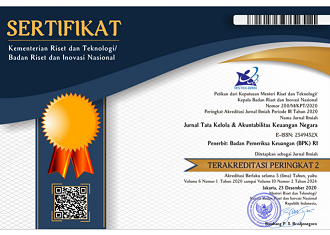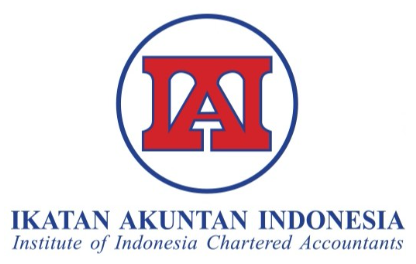EVALUASI ATAS IMPLEMENTASI APLIKASI SISTEM AKUNTANSI INSTANSI BASIS AKRUAL (SAIBA) PADA MITRA KERJA KPPN GORONTALO DAN MARISA
DOI:
https://doi.org/10.28986/jtaken.v2i2.65Keywords:
SAIBA, accrual, DeLone and McLean (DM), success model, sistem informasiAbstract
The purpose of this research is to evaluate the success of accrual basic application system (SAIBA) implementation based on user perception with DeLone & McLean (DM) Information System (IS) Success Model Approach. The data used are primary and secondary data. Primary data gathered through questionnaires distributed to respondents while secondary data gathered from other institutions such as the Directorate General of Budget, Directorate General of Treasury, and Treasury Office of Gorontalo and Marisa. This model uses six variables which are system quality, information quality, user satisfaction, use, individual impact, and organizational impact. This research empirically showed that the accrual basic application system (SAIBA) currently implemented not successfully running yet based on all Delone and McLean's success measurement criteria.
Abstrak
Penelitian ini bertujuan untuk mengevaluasi sejauh mana keberhasilan implementasi aplikasi SAIBA yang telah berjalan selama ini berdasarkan sudut pandang pengguna (user) dengan menggunakan pendekatan Delone & McLean Information System Success Model. Sumber data yang digunakan dalam penelitian ini berasal dari data primer dan data sekunder. Data primer berupa data yang diperoleh langsung dari responden melalui kuesioner yang dibagikan. Sedangkan data sekunder adalah data yang diperoleh dan disajikan oleh pihak-pihak lainnya seperti Direktorat Jenderal Anggaran Kementerian Keuangan, Direktorat Jenderal Perbendaharan Negara Kementerian Keuangan, dan Kantor Pelayanan Perbendaharaan Negara (KPPN) Gorontalo dan Marisa. Model ini menggunakan enam variabel pengukuran yaitu kualitas sistem (system quality), kualitas informasi (information quality), kepuasan pengguna (user satisfaction), penggunaan sistem (use), dampak individu (individual impact) dan dampak organisasi (organizational impact). Penelitian membuktikan secara empiris bahwa implementasi aplikasi SAIBA belum berjalan sukses berdasarkan kriteria pengukuran sesuai model kesuksesan DeLone dan McLean (1992).
References
Davis, F. D. (1989). Perceived Usefulness, Perceived Ease of Use, and User Acceptance of Technology. MIS Quarterly, 13 (3) ABI/INFORM global, 319-340.
DeLone, W. H., & McLean, E. R. (1992). Information Systems Success: The Quest for the Dependent Variable. Information Systems Research, 60-95.
Ghozali. (2008). Structural Equation Modeling metode alternatif dengan Partial Least Square, Edisi 2. Semarang: BP-Undip.
Goodhue, D. L. & Thompson, R. L. (1995). Task-technology fit and individual performance. MIS Quarterly, 19, 213-236.
Ives, B., Olson, M. & Baroudi, S. (1983). The Measurement of User Information Satisfaction, Communications of the ACM, October.
Janson, M. A., & Subramanian, A. (1996). Packaged software: Selection and Implementation Policies. INFOR, 34(2), 133-151.
Jogiyanto. (2005). Metodologi Penelitian Bisnis: Salah Kaprah dan Pengalaman, Yogyakarta: BPFE.
Jogiyanto. (2007). Model Kesuksesan Sistem Teknologi Informasi. Yogyakarta. Penerbit Andi.
Laudon, K. C., (1985). Environment and Institutional Models of Systems Development, Communication of the ACM, 28 (7).
Laudon, K. C., & Laudon, J. P. (2000). Organization and Technology in The Networked Enterprise. Management Information System, Six Edition, International Edition. www. prenhall.com/laudon.
Livari, J. (2005). An Empirical Test of the DeLone and McLean Model of Information System Success. DataBase for Advances in Information Systems. ABI/INFORM Global, 8-27.
Markus, M. L. & Keil, M. (1994). If We Build It, They Will Come: Designing Information Systems That People Want to Use. Sloan Management Review (Summer).
McGill, T., Hobbs, V., & Klobas, J., (2003). User-Developed Applications and Information Systems Success: A Test of DeLone and McLean's Model. Information Resources Management Journal. ABI/INFORM Research, 24- 45.
Nazir, M. (2003). Metodologi Penelitian. Jakarta, Ghalia Indonesia.
Peraturan Pemerintah (PP) Nomor 24 Tahun 2005 Tentang Standar Akuntansi Pemerintahan.
Peraturan Pemerintah (PP) Nomor 71 Tahun 2010 Tentang Standar Akuntansi Pemerintahan.
Purwanto, A. (2007). Rancangan dan Implementasi Model Pemeriksaan Kinerja Badan Pemeriksa Keuangan Republik Indonesia Atas Aplikasi E-Government di Pemerintah Daerah: Studi Kasus Kabupaten Sragen. Tesis, Program Pasca Sarjana Universitas Gajah Mada. Yogyakarta.
Radityo, D. & Zulaikha. (2007). Pengujian Model DeLone and McLean Dalam Pengembangan Sistem Informasi Manajemen (Kajian Sebuah Kasus). SNA X. Makasar.
Rai, A., Lang, S. S., & Welker, R. B. (2002). Assessing the Validity of IS Success Models: An Empirical Test and Theoretical Analysis. Information Systems Research. ABI/INFORM Global, 50-113.
Roldan, J. L. & Leal, A. (2003). A Validation Test of an Adaptation of the DeLone and McLean's Model in Spanish EIS Field. Idea Group Publishing. Diakses dari: business.clemson.edu/ISE/04chap. pdf.
Sarwono, J., & Narimawati, U. (2015). Membuat Skripsi, Tesis, dan Disertasi dengan Partial Least Square SEM (PLSSEM). Yogyakarta: Penerbit ANDI.
Seddon, P. & Siew-Kee, Y. (1992). An Empirical Evaluation of User Information Satisfaction (UIS) Measures for Use with General Ledger Accounting Software.
Sekaran, U. (2006). Research Methods for Business. 4th Ed. Jakarta: Salemba Empat.
Undang-Undang (UU) Nomor 1 Tahun 2004 tentang Perbendaharaan Negara.
Undang-Undang (UU) Nomor 17 Tahun 2003 tentang Keuangan Negara.
Downloads
Submitted
Accepted
Published
How to Cite
Issue
Section
License

Jurnal Tata Kelola dan Akuntabilitas Keuangan Negara is licensed under
a Creative Commons Attribution-ShareAlike 4.0 International License




















